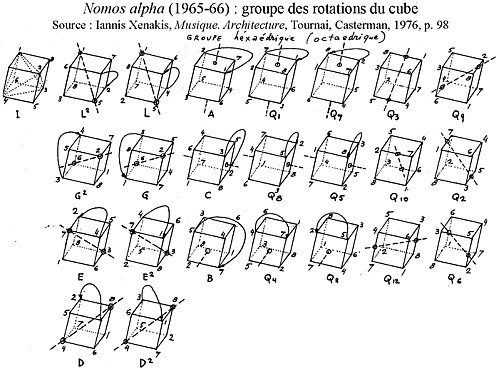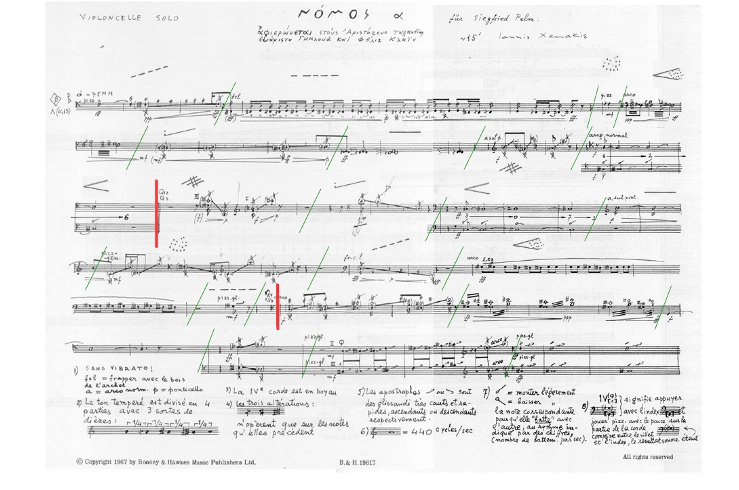The organisation of the basic sounds: the group theory
Source:Fernand Vandenbogaerde,
analysis of Nomos Alpha of I.Xenakis
I-/ The groups of transformations
In the previous chapter I explained about the two different paths (A and B) Xenakis is using within each of the six parts. The basic sounds in Path A of Nomos Alpha are organized with the cube transformation onto itself in space.
There are 24 cube transformations in the space. The apexes of the cube are numbered from 1 to 8 (corresponding to basic sounds) and forms 2 tetrahedrons: 1 2 3 4 and 5 6 7 8. Each transformation gives a different permutation of the eight first numbers.
In the tables below, the 24 cube transformations:
We notice two groups of transformations.
- The group A: start with the first tetrahedrons 1 2 3 4, for example the transformation D: 2 3 1 4– 6 7 5 8
- The group Q: start with the second tetrahedrons 5 6 7 8, for exemple the transformation Q1:7 8 6 5 – 3 4 2 1.
In the group A there are 12 transformations: A, B, C, D, D2, E, E2, G, G2, I, L and L2.
In the group Q there are 12 transformations: Q1, Q2, Q3, Q4, Q5, Q6, Q7, Q8, Q9, Q10, Q11 and Q12.
VI-/ The organisation of the lenghts, densities and intensities
These three parameters are organized with same concept as the basic sounds, with the cube transformations.
- there are 4 different intensities: mf, f, ff and fff.
- there are 8 different lenghts in second: 1-2.25-2.83-3.72-7.98-10-22.5
These parameters are grouped and like the basic sounds they are organized on each cube apexes like this:
IV-/ Last step from the subsets to the transformations
For the first section of Nomos Alpha, Xenakis choose in the subset V2 the transformation D, and for the second the transformation Q12 in the subset V4.
Reminder: the first product of the graph was V2.V4=V6 D є V2 and Q12∊ V4
so we have D.Q12 = Q4 and Q4∊V6
and so on...
Also we find sequence of the transformation for the organisation of the basic sounds:
we can see clearly the repetitions of the chain V2, V4, V6, V3, V5, V6.
The sequences of the transformations are organized by the product of the transformations as in the table below.
II-/ The subsets
In each group there are 3 subset:
-
in A we have: V1 = {I, A, B, C}, V2 = {D, E2,G, L2} and V3 = { D2, E, G2, L}.
-
in Q we have: V4 = {Q6, Q12, Q7, Q1}, V5 = {Q8, Q10, Q3, Q5} and V6 = {Q2, Q4, Q11 Q9,}
With the same reasoning as in Tables 1, we get the following table.
V-/ Analysis of the first two sections of Nomos Alpha
As we can see on the score beside, for the first section of Nomos Alpha Xenakis uses the transformation D, the sequence will be: 2 3 1 4 - 6 7 5 8. Consequently the order of the basic sounds in the first section should be:
III-/ The organisation of the basic sounds
Graphs and chains, how do they works ?
Example with the graph builting from V2 and V4 . this is the graph used for organizing the basic sounds.
First product V2.V4 = V6 (result obtained with table 2)
The next product is the second factor and the result of the previous product, here the next product will be V4.V6.
Therefore here is the totality of the graph:
V2.V4=V6 V4.V6=V3 V6.V3=V5 V3.V5=V6 V5.V6=V2 V6.V2=V4 V2.V4=V6
At the end we have found the same product (V2.V4=V6), so the cycle is over. Thus we get the chain: V2, V4, V6, V3, V5, V6.
As we can see in the form table of the piece there are 18 sections in the Path A, also this chain will be repeated 3 times. In this regard, each subset (V1, V2...V6) contains 4 transformations. Example: V2 = {D, E2,G, L2}
Therefore, in each repetition of the chain, Xenakis will chooses a different transformation in each subset.
From this table, it is possible to make several graphs. A graph is a set of products, where here a product of the subsets V1, V2...V6. This process creates a chain of products, and gives Xenakis the sequence of cube transformations. In Nomos Alpha, Xenakis uses the graph building from V2 and V4 for the basic sounds organisation, and the graph building from V3 and V5 for the lengths, densities and intensities.
The second section uses the transformation Q12, also the sequence will be: 5 6 8 7- 1 2 4 3, Consequently the order of the basic sounds in the first section should be:
After this analysis, we are going to look at several questions about the perforamnce of the piece in the next part: Guide for performers
Table abstract to : Fernand Vandenbogaerde,
analysis of Nomos Alpha of I.Xenakis1
Tables abstract to : Fernand Vandenbogaerde,
analysis of Nomos Alpha of I.Xenakis2
Table abstract to : Fernand Vandenbogaerde,
analysis of Nomos Alpha of I.Xenakis3
Observation: We notice that the transformations of the group A change the first tetrahedron (group A) in itself and the second (group Q) in itself (example 1).
On the contrary, the transformations of the Q group change the first tetrahedron in the second and conversely (example2).
Example 1:
A.A= A and A.Q=Q
That means, when the first term of the product is A the result of the product will be the second term.
Example 2:
Q.A= Q and Q.Q=A
That means, when the first term of the product is Q the result of the product will be the opposite of the second term..
Table abstract to : Fernand Vandenbogaerde,
analysis of Nomos Alpha of I.Xenakis4

